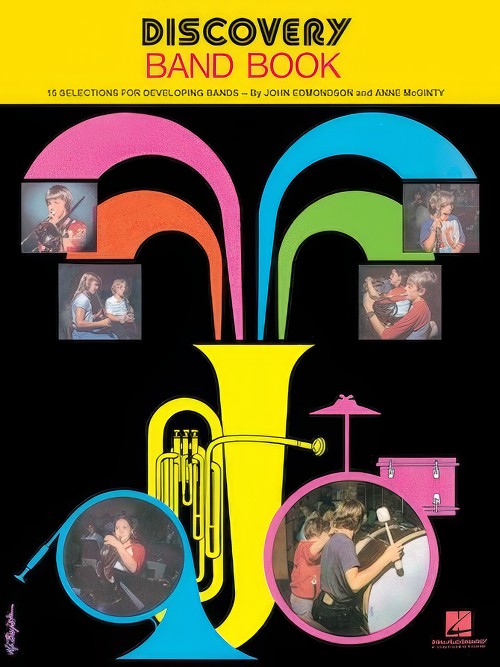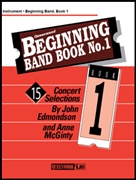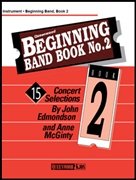Results
-
 £2.85
£2.85Discovery Band Book No.1 (Bass Clarinet) - Edmondson & McGinty
Contents:Concert Warm-Ups and ChoralesAmerican Spirit OverturePrelude to a FestivalHonor Roll MarchDixieland DazzleBartok's Three Folk SongsBreakdance BrassRazzamajazzGrandfather's ClockDiscovery MarchSuperflutesPercussion PatrolA Festive Christmas OvertureJingle-Bell RockFrosty the Snow Man.
Estimated dispatch 7-14 working days
-
 £2.85
£2.85Discovery Band Book No.1 (2nd Bb Clarinet) - Edmondson & McGinty
Contents:Concert Warm-Ups and ChoralesAmerican Spirit OverturePrelude to a FestivalHonor Roll MarchDixieland DazzleBartok's Three Folk SongsBreakdance BrassRazzamajazzGrandfather's ClockDiscovery MarchSuperflutesPercussion PatrolA Festive Christmas OvertureJingle-Bell RockFrosty the Snow Man.
Estimated dispatch 7-14 working days
-
 £2.85
£2.85Discovery Band Book No.1 (1st Bb Clarinet) - Edmondson & McGinty
Contents:Concert Warm-Ups and ChoralesAmerican Spirit OverturePrelude to a FestivalHonor Roll MarchDixieland DazzleBartok's Three Folk SongsBreakdance BrassRazzamajazzGrandfather's ClockDiscovery MarchSuperflutesPercussion PatrolA Festive Christmas OvertureJingle-Bell RockFrosty the Snow Man.
Estimated dispatch 7-14 working days
-
 £2.85
£2.85Discovery Band Book No.1 (Oboe) - Edmondson & McGinty
Contents:Concert Warm-Ups and ChoralesAmerican Spirit OverturePrelude to a FestivalHonor Roll MarchDixieland DazzleBartok's Three Folk SongsBreakdance BrassRazzamajazzGrandfather's ClockDiscovery MarchSuperflutesPercussion PatrolA Festive Christmas OvertureJingle-Bell RockFrosty the Snow Man.
Estimated dispatch 7-14 working days
-
 £2.85
£2.85Discovery Band Book No.1 (Flute) - Edmondson & McGinty
Contents:Concert Warm-Ups and ChoralesAmerican Spirit OverturePrelude to a FestivalHonor Roll MarchDixieland DazzleBartok's Three Folk SongsBreakdance BrassRazzamajazzGrandfather's ClockDiscovery MarchSuperflutesPercussion PatrolA Festive Christmas OvertureJingle-Bell RockFrosty the Snow Man.
Estimated dispatch 7-14 working days
-
 £15.99
£15.99Discovery Band Book No.1 (Conductor) - Edmondson & McGinty
Contents:Concert Warm-Ups and ChoralesAmerican Spirit OverturePrelude to a FestivalHonor Roll MarchDixieland DazzleBartok's Three Folk SongsBreakdance BrassRazzamajazzGrandfather's ClockDiscovery MarchSuperflutesPercussion PatrolA Festive Christmas OvertureJingle-Bell RockFrosty the Snow Man.
Estimated dispatch 7-14 working days
-
 £49.50
£49.50A Crazy, Mixed-Up Opera
Oh NO! It's happened again! Several years ago as the town band prepared their annual holiday concert, somehow the music got mixed up in the folders and upon the downbeat the rest was painful music history. This time the mix-up includes the ranting recitatives and aimless arias from some of the most famous opera tunes of all times. This crazy, mixed-up opera concert is sure to be the hit of your next program!
Estimated dispatch 7-14 working days
-
£54.99
A Day Off Wind Band Set (Score & Parts)
The pleasure of waking up on your day off. No school and all the time in the world to do what you want. The members of your band will recognise this feeling in the atmosphere that the composer of this piece has created. Highly recommended! 02:15
Estimated dispatch 7-14 working days
-
 £22.50
£22.50BEGINNING BAND BOOK No.1 (Score inc. CD) - Edmondson & McGinty
An affordable collection of concert repertoire for beginning bands; great sight reading material for more advanced bands! Features include: Grade 1 concert band music; Playable with only 1 flute, 2 clarinets, 1 alto saxophone, 2 cornets/trumpets and percussion, up to full instrumentation; Full, complete sound, even without bass clef instruments. The bass clef part in octaves is optional; Both clarinet parts stay below the break; Optional F Horn and Tenor Saxophone parts are written in their best ranges; Bell part for teaching melodic percussion. Contents: Anasazi; Bartok: Folk Song and Dance; The Buglers; Chant and Praise; Chorale and Recessional; Clarinet, Caprice; Echoes; Let's Take a Break; Manchester March; Old MacDonald's Band; Somerset Overture; Those Fabulous Flutes; Two Canadian Folk Songs; Westwind Overture; Yorktown March.
Estimated dispatch 7-14 working days
-
 £22.50
£22.50BEGINNING BAND BOOK No.2 (Score inc. CD) - Edmondson & McGinty
An affordable collection of concert repertoire for beginning bands; great sight reading material for more advanced bands! Features include: Grade 1 concert band music; Playable with only 1 flute, 2 clarinets, 1 alto saxophone, 2 cornets/trumpets and percussion, up to full instrumentation; Full, complete sound, even without bass clef instruments. The bass clef part in octaves is optional; Both clarinet parts stay below the break; Optional F Horn and Tenor Saxophone parts are written in their best ranges; Bell part for teaching melodic percussion. Contents: Air and Allegro; Bandissimo; Cumberland Gap; Diamond Ridge (Concert March); English Folk Trilogy; Fantasy on a French Folk Song; Hickory Dickory Rock; Kitty Hawk March; Montezuma's Castle; Percussion Parade; Prelude and Dance; Old Band; Those Sophisticated Saxes; Those Terrific Trumpets; Windsor Overture.
Estimated dispatch 7-14 working days
